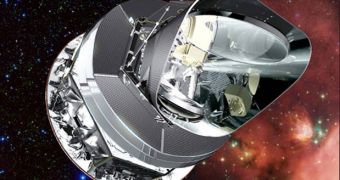The recently launched Planck telescope has just begun observing the early Universe, accumulating background radiation that was most likely created when the Universe first sprung into being. The mission is conducted by the European Space Agency (ESA), with vast collaboration from NASA. In addition to the observatory, the same Ariane 5 heavy-lift rocket also delivered the Herschel Space Telescope to a similar L2 Lagrangian orbital point. The main goal of the Planck mission is to analyze the cosmic microwave background (CMB), and determine how the Universe formed.
Using complex and state-of-the-art scientific instruments, over the next few years, Planck will look at this background light, and record any small variations within it, which may hint at yet undiscovered phenomena that took place in the first few seconds after the Big Bang. These variations, if uncovered, could also lead astronomers to new theories about dark matter and dark energy, and explain a wide array of peculiar events that astronomers cannot yet account for.
The new observations, which began on August 13, are only part of a test trial, but, if all goes well, mission controllers announce that, over the next 15 months or so, two full-sky scans of the entire Universe will be conducted. Actual scientific data from the mission are not expected to be made available to the public for at least another three years, although preliminary studies are likely to be published. There is a lot of analysis to be done on the 13.7-billion-year-old light, and experts do not wish to compromise the final conclusions of the science mission by making unfounded assumptions earlier on.
The US Planck team will play a major role in data and science analyses, with a primary tool being the Franklin supercomputer at the National Energy Research Scientific Computing Center, in Berkeley, California. One of the world's fastest computers, Franklin, will handle the most computationally intensive analysis jobs for the Planck team worldwide. The team will produce a catalog of cosmic objects, called the Early Release Compact Source Catalog (ERCSC), which will be released to the public nine months after completion of the first sky survey.

 14 DAY TRIAL //
14 DAY TRIAL //